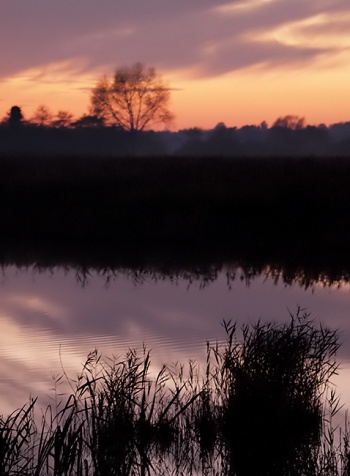Overview
Situated beside the River Yare in the southern part of the Norfolk Broads, this reserve consists of wet grazing marshes, open broads and reedbeds, carr woodland and a small deciduous wood.
Birds
Notable Species
The reedbeds hold a thriving population of Bearded Tit as well as numerous Common Reed Warbler and Sedge Warbler and Cetti's Warbler, Grasshopper Warbler and other warblers nest in the carr and scrub.
Great Crested Grebe and Little Grebe, Gadwall, Northern Shoveler and Common Pochard are present all year as are Grey Heron, Water Rail, Northern Lapwing, Common Snipe and Common Redshank. Garganey is a regular spring migrant that sometimes stays to breed and Common Kingfisher can be seen throughout the year.
The woodlands hold Eurasian Sparrowhawk, Tawny Owl and all three British woodpeckers, Marsh Tit and Willow Tit, Eurasian Nuthatch and Common Treecreeper. Western Barn Owl hunts over the grazing marshes joined by Marsh Harrier in summer and Hen Harrier in winter.
Wintering waterfowl include all the breeding species as well as Eurasian Wigeon, Common Teal, Northern Pintail, Common Goldeneye and Ruddy Duck.
Rarities
Mandarin Duck, Red-crested Pochard and Spotted Crake are among the scarcer species that have been recorded at Strumpshaw and Great Grey Shrike and Great Bittern are occasional visitors. Glossy Ibis is among the rarities seen here.
Check-list
Birds you can see here include:
Little Grebe, Great Crested Grebe, Great Bittern, Grey Heron, Taiga Bean Goose, Greater White-fronted Goose, Eurasian Wigeon, Gadwall, Common Teal, Mallard, Northern Pintail, Garganey, Northern Shoveler, Common Pochard, Tufted Duck, Common Goldeneye, Ruddy Duck, Marsh Harrier, Hen Harrier, Eurasian Sparrowhawk, Common Kestrel, Merlin, Peregrine Falcon, Common Pheasant, Water Rail, Common Moorhen, Eurasian Coot, European Golden Plover, Northern Lapwing, Dunlin, Common Snipe, Common Redshank, Common Greenshank, Green Sandpiper, Wood Sandpiper, Common Sandpiper, Black-headed Gull, Common Cuckoo, Western Barn Owl, Tawny Owl, Short-eared Owl, Common Kingfisher, Green Woodpecker, Great Spotted Woodpecker, Lesser Spotted Woodpecker, Eurasian Skylark, Meadow Pipit, Yellow Wagtail, Pied Wagtail, Common Wren, Dunnock, Eurasian Robin, Eurasian Blackbird, Fieldfare, Song Thrush, Redwing, Mistle Thrush, Cetti's Warbler, Common Grasshopper Warbler, Sedge Warbler, Common Reed Warbler, Lesser Whitethroat, Common Whitethroat, Blackcap, Garden Warbler, Common Chiffchaff, Willow Warbler, Goldcrest, Spotted Flycatcher, Bearded Tit, Long-tailed Tit, Marsh Tit, Willow Tit, Coal Tit, Blue Tit, Great Tit, Eurasian Nuthatch, Common Treecreeper, Great Grey Shrike, Common Magpie, Carrion Crow, Common Starling, House Sparrow, Chaffinch, European Greenfinch, European Goldfinch, Eurasian Siskin, Lesser Redpoll, Common Bullfinch, Reed Bunting
Other Wildlife
There are many species of butterfly present on the reserve including the Swallowtail Papilio machaon, which is rare in Britain and breeds on its host plant, Milk Parsley Peucedanum palustre, its host plant, growing amongst the reeds and sedges. Hundreds of species of moth have been recorded by trapping at night and dragonflies of various species occur including the local Norfolk Hawker Aeshna isosceles.
Mammals present include the introduced Chinese Water Deer Hydropotes inermis, sometimes seen at dawn, as well as Weasel Mustela nivalis, Red Fox Vulpes vulpes and the rare Otter Lutra lutra.
Amphibians such as Common Frog Rana temporaria, Common Toad Bufo bufo and Smooth Newt Triturus vulgaris occur as well as Grass Snake Natrix natrix and Common Lizard Lacerta vivipara.
The plants found here attract many visitors and include several species of orchid, Purple Loosestrife Lythrum salicaria, Marsh Pea Lathyrus palustris, scarce Water Soldier Stratiotes aloides and the rare Marsh Sow-thistle Sonchus palustris.
Site Information
Areas of Interest
The nearby Buckenham Reserve is an area of grazing land specifically managed to cater for England's only regular flock of wintering Taiga Bean Goose. The fields here sometimes have other geese including Egyptian Goose wandering from their main stronghold in the Holkham area.
Access and Facilities
Strumpshaw Fen is reached by turning off the A47 Norwich-Great Yarmouth road through Brundall from where it is signposted. The #17 bus from Norwich Castle Meadow reaches a stop just beyond Brundall, a short distance from the reserve.
Grid Ref: TG341065
There are hides overlooking the broads on the reserve and another at Buckenham Reserve.
Contact Detials
Tel: 01603 715191
External Links
- RSPB: Strumpshaw Fen
- Strumpshaw Fen on Streetmap
- RSPB Buckenham Reserve
- Buckenham Reserve on Streetmap
Content and images originally posted by Steve
Reviews
keithyed's review
always bitterns and harriers around, always see kingfishers fishing at close range. has a great tree hide overlooking the marsh area. Swallowtail butterflies in the summer
Pros
- good hides
- variety of habitats
- all year good birding spot
Cons
- very muddy after rain
Tim P's review Currently lost the Bean Goose Hide. I've seen my second kingfisher only recently. Always good views of Marsh Harrier. Pros
- Superb in Spring and Winter
Cons
- A little slow in the summer





